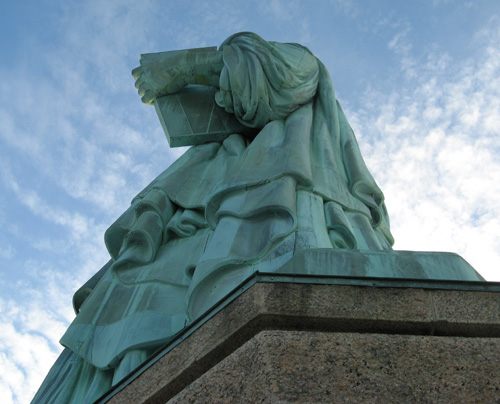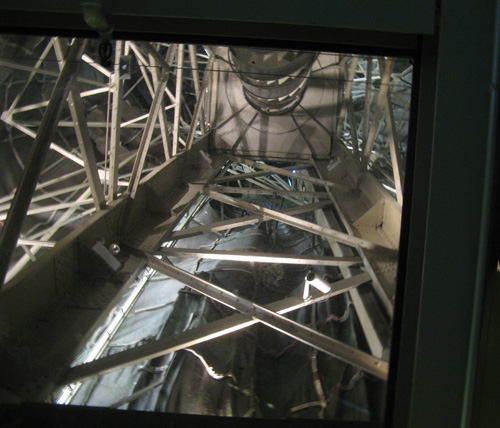On Tuesday, largely at the instigation of the Free-Ride offspring, the Free-Ride family went to Liberty Island to see the Statue of Liberty.

It was a brutally cold day (with temperatures around 20 oF), not the kind of day that I go out looking for a patriotism lesson. So I was pleasantly surprised at the extent to which the ranger tour and the museum exhibit (inside! w00t!) focused on issues of engineering and science.
First off, there’s the matter of Lady Liberty’s size. Creating and installing a statue of this size (not to mention transporting it from France to the U.S.A.) was a major undertaking. The statue is made of copper — not solid copper, but sheets of copper about the thickness of two pennies hammered into shape. Even that (relatively) thin copper skin is pretty heavy, so solid copper would be extremely heavy, not to mention pretty expensive.
There were some nice video loops of the fabrication of feet for the statue in the 1980s (I think as part of a restoration?) that showed the transformation from flat sheets of copper to statue panels. There was fire and hammering, which is to say it looked like fun.
The project of building the wooden forms used to shape the copper sheets was also interesting. It started with a small statue that needed to be scaled up (a good, mathy activity), followed by full-sized plaster models of the various pieces, around which wooden forms (sort of the “negatives” of the plaster pieces) were carefully built.

Then there was the question of how to support all those carefully shaped copper pieces. Bartholdi, the artist, had originally engaged the architect Viollet-le-Duc to figure out how to keep the statue up — not in some climate controlled museum, remember, but on an island in a windy harbor, exposed to significant temperature fluctuations. Viollet-le-Duc intended to fill the statue with something heavy (like sand) to provide strength and stability.
Luckily for Bartholdi, Viollet-le-Duc died in 1879, and Eiffel (of the eponymous tower) was engaged as his replacement. Eiffel had some more exciting ideas about how to solve this engineering problem. At this point, let me quote directly from the museum’s description of the statue’s inner structure:
Eiffel’s innovative plan for constructing the Statue began with a wrought iron central pylon surrounded by a secondary framework of cross-braced iron angle bar. To these he attached a massive truss supporting the torch arm. Most brilliant of all, however, was his concept of flat iron bars to connect the skin support system to the secondary framework. Installed in compression, these flat bars, 2 x 3/4 inches (50 x 19 millimeters), act like springs, allowing the skin to adjust to changes in stress from temperature and wind pressures.
You can see just a little of that inner structure here.

And this was really just the beginning of the science-y content. There’s also the whole electrochemistry angle: If the Statue of Liberty is made of copper, why is it green? (Let’s talk about oxidation.) Why were the iron support bars replaced with steel ones? (Let’s talk about galvanic action.)
Plus, we had occasion to consider why going up 156 steps is harder than going down 156 steps.
Not to mention thinking about why we could see our breath.

I love taking the Staton Island ferry to Manhatten, and done it numerous times, just becasue you get such a good look at the statue – but have naver taken the tour, so thanks! The engineering stuff is all bonus, and stuff I did not know, so thanks again.
Fascinating post, SG! Comrade PhysioProf spent decades of his life in New York City, but never visited the statue of liberty.
If the authors of the patriot act had had a shred of honesty, they would have included an amendment to bomb the Statue of Liberty into rubble – since that’s what it did with the statutes of liberty. Today the Statue of Liberty is a memory of an America that no longer is.
But it’s a beautiful statue, and the process of its design, construction, and erection is fascinating.
One of the bits of history that caught my eye in the museum was how threatening the idea of liberty actually was (in Europe and among the rich and powerful in the U.S.) when Bartholdi proposed to build the Statue of Liberty and present it as a gift to the American people. His sense was that the U.S. experiment in Constitutional government was vital not just for U.S. citizens but for the whole world.
Which is to say, regardless of what the government may think or do, the people of the U.S. ought to take liberty — with all its privileges and responsibilities — seriously, and to be prepared to overthrow any U.S. government that would take it away. Luckily, elections give us a chance to do just that, at least on a limited scale, at regular intervals.
I visited the Statue of Liberty as a grade-school kid in the middle 50’s.
She looks as good as ever, thanks to the restoration. And the math-y and science-y parts are as informative as ever.